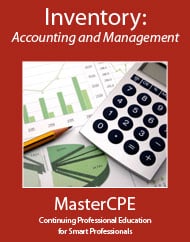Course Information
Inventory: Accounting and Management
Course Information
| Title: | Inventory: Accounting and Management |
|---|---|
| Category: | Accounting and Auditing |
| Field of Study: | Accounting |
| Course Code: | M220 |
| CPE Credits: | 6.0 |
| Price: | 49.95 |
Description
Description:
Inventory usually represents a substantial portion of a manufacturing or merchandising company’s total assets: on average, it is more than 30% of total current assets for a U.S. company. Inventory management has a significant influence on a company’s cash flow and continued viability, and as an asset on the balance sheet, inventory can have a direct impact on reporting the solvency of the company. Thus, determining ideal inventory levels is a balancing act and a key to a healthy and growing business. This course is designed to address the main accounting principles and concepts applicable to inventory. It shares insights and techniques focused on improving inventory optimization processes, forecasting accuracy, and replenishment strategies. It also discusses common warning signs of inventory fraud, investigation techniques, and some control activities to mitigate risks. This course also identifies the uses of technology to improve inventory management systems. Finally, risk areas, processes, and tips for plan
Delivery Method: Online Interactive Self Study
Level: Overview
Prerequisites: None
Advanced Preparation: None
Course Details
Category: Accounting and Auditing
Field of Study: Accounting
Passing Score: 70%
Technical Details: Accounting: Technical
For More Detail:
If you are unable to view PDF then right click the mouse and click save link as
Objectives
Objectives:
Chapter 1: Accounting and Reporting Inventory 1. Identify the characteristics of merchandising, manufacturing, and service companies 2. Recognize the components of inventory costs 3. Recognize how to account for inventories including consigned goods, and lower of cost or market 4. Distinguish between perpetual and periodic inventory systems 5. Indicate several inventory costing methods including FIFO, LIFO, and weighted average approach 6. Identify proper disclosure requirements for inventory and change in the inventory costing method 7. Recognize key differences between IFRS and GAAP in accounting for inventory
For More Objectives:
If you are unable to view PDF then right click the mouse and click save link as
Profession
NASBA: Yes
QAS: Yes
CPA: Suitable for all CPAs
IRS: No IRS credit for Enrolled Agents.
Profession Identifiers: CPA

